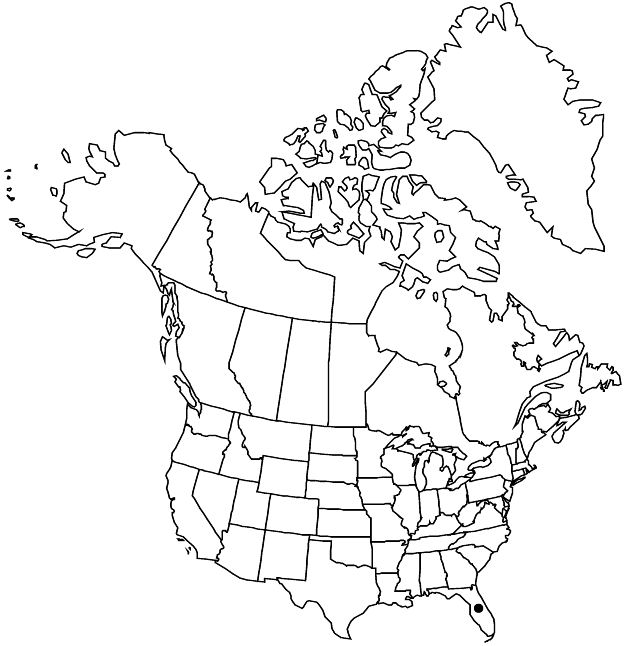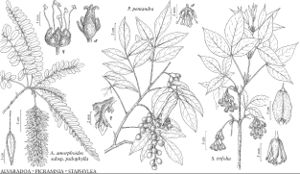Difference between revisions of "Alvaradoa amorphoides subsp. psilophylla"
Brittonia 5: 135. 1944.
FNA>Volume Importer |
FNA>Volume Importer |
||
| Line 30: | Line 30: | ||
|elevation=0–20 m | |elevation=0–20 m | ||
|distribution=Fla.;West Indies (Bahamas;Cuba). | |distribution=Fla.;West Indies (Bahamas;Cuba). | ||
| − | |discussion=<p>In the flora area, subsp. psilophylla is found in Miami-Dade County. Specimens of subsp. amorphoides from Mexico and Central America are, in general, more robust with longer, narrower fruits. Plants of subsp. amorphoides occur in a wider variety of habitats and are not obligate on limestone formations as are those of subsp. psilophylla.</p> | + | |discussion=<p>In the flora area, <i></i>subsp.<i> psilophylla</i> is found in Miami-Dade County. Specimens of subsp. amorphoides from Mexico and Central America are, in general, more robust with longer, narrower fruits. Plants of subsp. amorphoides occur in a wider variety of habitats and are not obligate on limestone formations as are those of <i></i>subsp.<i> psilophylla</i>.</p> |
|tables= | |tables= | ||
|references= | |references= | ||
| Line 54: | Line 54: | ||
|publication year=1944 | |publication year=1944 | ||
|special status=Selected by author to be illustrated | |special status=Selected by author to be illustrated | ||
| − | |source xml=https://jpend@bitbucket.org/aafc-mbb/fna-data-curation.git/src/ | + | |source xml=https://jpend@bitbucket.org/aafc-mbb/fna-data-curation.git/src/8f726806613d60c220dc4493de13607dd3150896/coarse_grained_fna_xml/V9/V9_4.xml |
|genus=Alvaradoa | |genus=Alvaradoa | ||
|species=Alvaradoa amorphoides | |species=Alvaradoa amorphoides | ||
Revision as of 18:16, 18 September 2019
Shrubs or trees, 10–70 dm. Stems of current year puberulent. Leaves glabrous except for puberulent rachis; rachis (including petiole) 9.5–21 cm; petiolules 1–1.5 mm; leaflets 17–35, abaxially pale green, adaxially olive, oblong to elliptic, 5–8(–10) × 14–19 mm, apex rounded. Racemes pendent; staminate-flowered racemes 7–15 cm, puberulent; pistillate-flowered racemes 7–10 cm, pubescent. Pedicels: staminate 1.5–2 mm; pistillate 1–2 mm. Staminate flowers: sepals 5, ovate, 1.5 mm, puberulent; petals 5, filiform, 3–3.5 mm, narrower than filaments; intrastaminal discs lobed; stamens 5, filaments 2–5 mm; pistils vestigial. Pistillate flowers: sepals 5, ovate, puberulent; petals 0; intrastaminal discs circular, thin, unlobed; stamens 0; pistils 3-carpellate, ovate, flattened, 2–2.2 × 1–1.4 mm, pubescent, stigmas unequal, 2 at apex of ovary, divergent, 3d slightly more proximal along medial line of pistil, sometimes only distal 2 stigmas present, 1 larger than other. Samaras stramineous or purplish tinged, flattened, (8–)10–12 × 2.7–3.2(–4) mm, dry, margins ciliate, puberulent; pedicels 6–10 mm.
Phenology: Flowering and fruiting year-round.
Habitat: Hammocks, pine woodlands, on limestone
Elevation: 0–20 m
Distribution

Fla., West Indies (Bahamas, Cuba).
Discussion
In the flora area, subsp. psilophylla is found in Miami-Dade County. Specimens of subsp. amorphoides from Mexico and Central America are, in general, more robust with longer, narrower fruits. Plants of subsp. amorphoides occur in a wider variety of habitats and are not obligate on limestone formations as are those of subsp. psilophylla.
Selected References
None.
